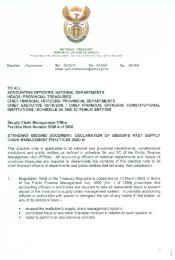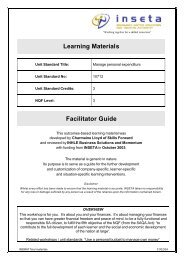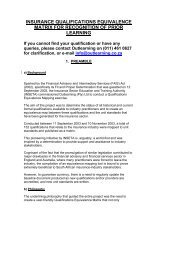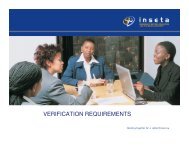SSP Brochure:Layout 1 - INSETA
SSP Brochure:Layout 1 - INSETA
SSP Brochure:Layout 1 - INSETA
You also want an ePaper? Increase the reach of your titles
YUMPU automatically turns print PDFs into web optimized ePapers that Google loves.
In this <strong>SSP</strong> update the demand model was further developed and expanded to provide for the projection of the need for Blackmanagers to comply with the FSC targets set for the Financial Services Sector. The methodology used and the findings of thisextension of the model can be seen in Annexure C.An initial analysis of industry performance against FSC targets indicate that the sector is very close to the targets set for 2008. If thesector does not grow and if the assumptions with regard to replacement demand are held the same for all managers, then the sectorwould need 365 senior managers and 405 middle and junior managers per year over the five-year period from 2005 to 2010. If therace and gender profile reflected in the WSPs submitted to the <strong>INSETA</strong> for the period 2006/2007 is to be maintained (scenario 1in Table 2.5) , the sector would need to train (or recruit) approximately 60 Black men and 60 Black women as senior managers eachyear. However, if the sector would attempt to increase the proportion of Black men in senior management positions to 20% andthat of Black women to 15% then the sector would have to train approximately 140 of each each year. If transformation were to bedriven at this pace, the attrition of white managers will have to be more that the figures provided for in the model.Table 2.5 Projections of the demand for managers in the insurance sector for the five year period 2005 to 2010Scenario 1 Distribution (%) Scenario 2 Distribution (%)Black Black WhiteBlack Black WhiteMale FemaleMale FemaleSenior management 15 10 75 20 15 65Middle to junior management 24 21 55 30 30 40Senior managementBlackMaleBlackFemaleWhite Total BlackMaleBlackFemaleNew employees 132 178 323 633 484 530 -381 633Replacement 179 119 893 1 191 238 179 774 1 191Total needed 2005 to 2010 310 297 1 216 1 823 722 709 393 1 823Total needed per year 62 59 243 365 144 142 79 365Middle to junior managementBlack Black White Total Black Black White TotalMale FemaleMale FemaleNew employees 269 197 237 702 738 900 -936 702Replacement 317 277 727 1 321 396 396 529 1 321Total needed 2005 to 2010 586 474 963 2 023 1 134 1 296 -407 2 023Total needed per year 117 95 193 405 227 25 -81 405WhiteTotal2.6 ConclusionsAt this stage evidence suggests that the demand for labour in the insurance sector is not anticipated to increase substantially over the nextfive years, and replacement demand is expected to be higher than new demand. It is estimated that the sector will need to train between4 000 and 6 000 new employees to meet employment needs. Not all these employees will be new entrants into the labour market.However, most of those in the managerial and professional categories will have to be Black in order to meet the sector’s transformationobjectives.The demand projections presented in this chapter should be seen as very conservative, because it is uses a base employment figure thatexcludes micro enterprises and self-employed individuals. In fact, micro enterprises may contribute substantially to employment growth –especially if the sector can produce enough brokers (who comply with the FAIS requirements) to access and service new and emergingmarkets.Overall, the sector is in a process of professionalisation, and higher skills levels are required in all occupational categories. The need for higherlevels of skills is specifically created by the regulatory requirements that affect all aspects of the sector.The initial transformation targets of the sector are set out in the FSC. In this chapter two scenarios have been developed regarding theneed for Black male and Black female managers in order to meet or exceed the minimum targets set in the FSC.<strong>INSETA</strong> Sector Skills Plan - page 20
















